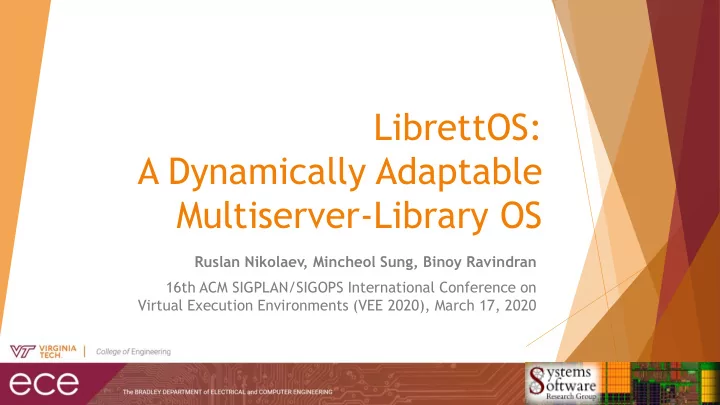

LibrettOS: A Dynamically Adaptable Multiserver-Library OS Ruslan Nikolaev, Mincheol Sung, Binoy Ravindran 16th ACM SIGPLAN/SIGOPS International Conference on Virtual Execution Environments (VEE 2020), March 17, 2020 1
Motivation The monolithic OS design is inadequate for [Herder et al. ACSAC’06], modern systems [Nikolaev et al. SOSP’13], [Kantee login’14], Lack of isolation, failure recovery, large [Lankes et al. ROSS’16], trusted computing base (TCB) [Decky 2017] Kernel-bypass libraries or library OS improve performance 2
Motivation The monolithic OS design is inadequate for [Herder et al. ACSAC’06], modern systems [Nikolaev et al. SOSP’13], Lack of isolation, failure recovery, large [Kantee login’14], trusted computing base (TCB) [Lankes et al. ROSS’16], [Decky 2017] Kernel-bypass libraries or library OS improve performance Multiple OS paradigms seamlessly integrated in the same OS are desirable Application-specific requirements (performance, security) Shared driver code base No code rewrite (POSIX compatibility) Limited physical (e.g., SR-IOV) resources Dynamic switch 3
Example: Server Ecosystem The network server for most applications 4
Example: Server Ecosystem Direct access for certain applications 5
Rump Kernels and Rumprun The concept is introduced by Antti Kantee and NetBSD community NetBSD code consists of anykernel components with can be used in both kernel and user space The rumprun unikernel is effectively a library OS 6
Rump Kernels and Rumprun Pros Very flexible Reuse most of NetBSD code (both drivers and the user-space environment) The rump kernel part is upstreamed A permissive license (2-Clause BSD) for the most code Cons Rumprun lacks SMP and Xen HVM support The unikernel model is not always suitable 7
LibrettOS Based on rumprun Adds SMP and Xen HVM support Reuses NetBSD’s device drivers and user-space environment Uses the Xen hypervisor A more advanced OS model Our prototype implements the network server Applications can also directly access resources (NIC, NVMe) Dynamic switch 8
LibrettOS Architecture Direct mode applications 9
LibrettOS Architecture Network server 10
LibrettOS Architecture Applications that use servers 11
Network Server A low-level design (direct L2 forwarding) TCP runs in the application address space A full recovery is possible as long as TCP does not time out Accommodates two paradigms easily A dynamic switch is feasible Fast IPC Uses Xen-specific capabilities (e.g., shared memory, VIRQ) Lock-free queues 12
Network Server The IPC channel exchanges mbufs Rx/Tx lock-free ring buffers (shared memory) Virtual interrupts (VIRQ) 13
Network Server: Portmap Table The portmap (port-to-domain map) table is kept in Xen 64K entries for TCP and 64K entries for UDP Can be accessed (read-only) by the network server Applications issue a port-bind hypercall 14
Dynamic switch Applications that do not need a dynamic switch, use the network server and share the same IP 15
Dynamic switch Applications that need a dynamic switch, reserve a dedicated IP when connecting to the network server. Initially their VIF redirects packets the network server 16
Dynamic switch When the dynamic switch is requested, the corresponding IP is deactivated on the network server side, and the corresponding physical interface is configured 17
Dynamic switch Applications that always need direct access avoid an intermediate VIF and access the physical interface directly 18
Evaluation: System Configuration Processor 2 x Intel Xeon Silver 4114, 2.20GHz Number of cores 10 per processor, per NUMA node HyperThreading OFF (2 per core) TurboBoost OFF L1/L2 cache 64 KB / 1024 KB per core L3 cache 14080 KB Main Memory 96 GB Network Intel x520-2 10GbE (82599ES) Storage Intel DC P3700 NVMe 400 GB Xen 4.10.1 Linux 4.13 NetBSD 8.0 + NET_MPSAFE 19 Jumbo Frames (mtu = 9000)
Evaluation NetPIPE: network throughput (a ping pong benchmark) 64 bytes .. 512 K All systems except the original Rumprun-PV have comparable performance 20
Evaluation NFS server Executing Sysbench/FileIO from the client machine Direct NVMe initialized with ext3, mixed I/O 21
Evaluation Nginx HTTP server 10,000 requests from the client side Concurrency 1 .. 60 Blocks 4K .. 128K LibrettOS has a better performance for smaller blocks 22
Evaluation Nginx: Dynamic Switch Concurrency 20 LibrettOS-Hybrid: 50% in direct mode and 50% in server mode 23
Evaluation Memcached (a distributed memory caching system) The memcache_binary protocol 1:10 of SET/GET operations (read-dominated) Each thread runs 10 clients, each client performs 100,000 operations 24
Evaluation Redis (in-memory key-value store) 1,000,000 SET/GET operations, 128 bytes Various number of concurrent connections 25
Evaluation Failure recovery One application (Nginx uses the network server) Two applications: Nginx and Redis 26
Related Work Multiserver OS MINIX 3 [ACSAC’06], HelenOS, QNX Multiserver approaches for monolithic systems SawMill, VirtuOS [SOSP’13], Snap [SOSP’19] Kernel-bypass libraries DPDK, SPDK Library OS approaches IX [OSDI’14], Arrakis [OSDI’14 ] Unikernels UKL [HotOS’19] 27
Conclusions LibrettOS is an OS that unites two models: multiserver and library OS LibrettOS is the first to seamless integrate these two models The same driver base (inherited from NetBSD) Applications do not need to be modified A dynamic switch is possible Applications can switch from the network server to direct mode with no interruption at runtime Our prototype solves a number of technical challenges SMP support, Xen HVM support 28
Availability LibrettOS’s source code is available at http://librettos.org 29
Availability LibrettOS’s source code is available at http://librettos.org THANK YOU! Artwork attribution: NetBSD, Xen, nginx, memcached, redis, 10 GEA, NVM Express logos are from Wikipedia. The rump kernel logo is from rumpkernel.org. Xen logo/mascot belongs to 30 XenProject.org. All other logos belong to their corresponding authors and/or projects.
Recommend
More recommend